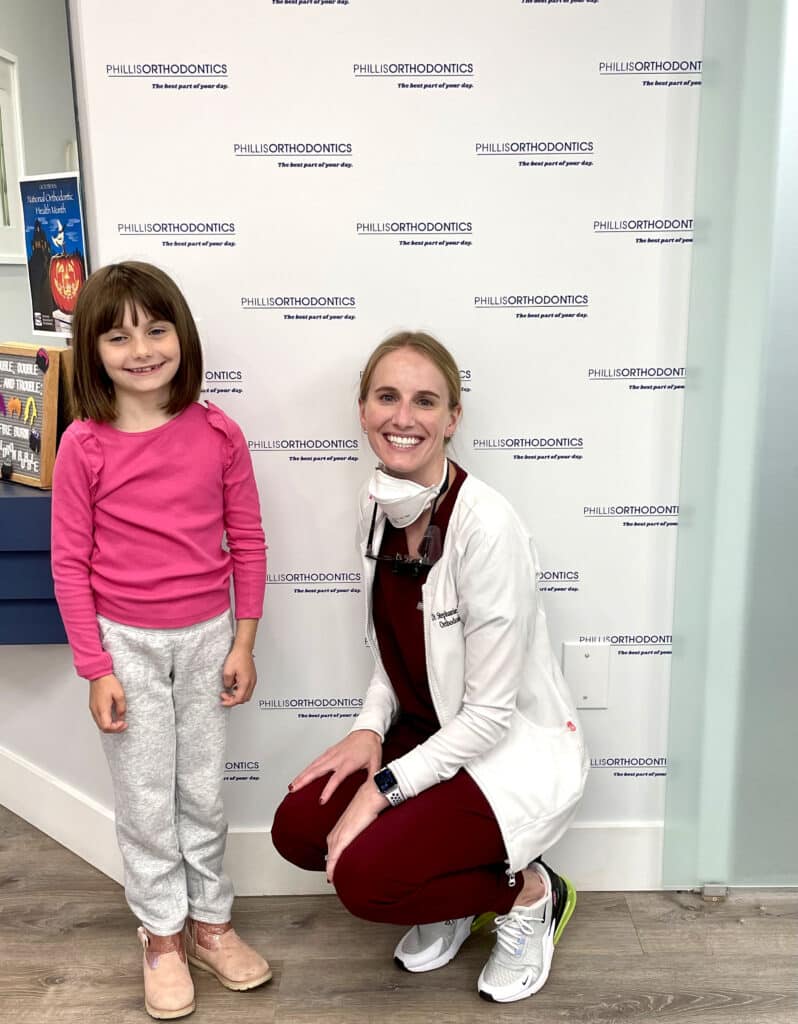At What Age Should a Child First Visit the Orthodontist?
The American Association of Orthodontists recommends that children have their first orthodontic screening by age 7. This early evaluation allows Drs. Hugh and Stephanie Phillis will assess whether orthodontic treatment is necessary and determine the ideal beginning time. Many local dentists are trained to spot early signs of orthodontic issues and may refer your child to our office even before age 7 if they notice potential concerns.
Why Evaluate Children at Such an Early Age?
Early diagnosis and treatment help guide growing teeth into better alignment, preserve space for permanent teeth, and reduce the risk of damage to protruding front teeth.
If early treatment is recommended, Drs. Hugh and Stephanie Phillis can influence the growth of the jaw and help permanent teeth erupt correctly. Early treatment can:
- Adjust the width of the upper and lower dental arches.
- Create space for incoming permanent teeth.
- Minimize the need for permanent tooth extractions.
- Reduce the risk of impacted teeth.
- Correct habits like thumb-sucking.
- Address abnormal swallowing or speech issues.
- Alleviate social or emotional concerns related to a child’s smile.
Some children benefit from “Phase 1” or early orthodontic treatment. Drs. Phillis may recommend early treatment when:
- A problem will worsen without intervention.
- The issue can be addressed more effectively now than later.
- Growth alone cannot resolve the problem.
Common early orthodontic treatments we provide include:
- Palate expanders.
- Limited braces.
- Tooth-moving retainers.
- Space maintainers.
Not every child needs an early phase of orthodontic treatment. For some, waiting until the teen years, when all permanent teeth have erupted, may be the most efficient approach.
Does Early Treatment Benefit Every Child?
Not all children require early treatment. Certain orthodontic issues are more effectively addressed during the teen years once all permanent teeth have erupted. Some skeletal problems also benefit from waiting until growth is more advanced or complete.
Drs. Philliscreatese individualized treatment plans for every child. If immediate treatment isn’t necessary, your child may be enrolled in our Orthodontic Supervisory Program to monitor their development. However, having an evaluation by age 7 is still essential to identify potential concerns early.
What Is the Orthodontic Supervisory Program?
This program is designed for children who aren’t ready for treatment. It allows us to monitor the growth and development of their teeth and jaws. Early interventions, like removing baby teeth, can improve the alignment of permanent teeth and reduce the overall time needed for braces.
We’ll evaluate your child’s progress during each visit and notify your family dentist of any recommendations. These visits typically occur every 6–8 months and help ensure treatment begins at the most effective time for the best possible results. This program is provided at no additional cost.
Benefits of Orthodontic Treatment
Orthodontic care does more than create a stunning smile. It also:
- Enhances bite function and chewing ability.
- Makes teeth easier to clean, promoting better oral hygiene.
- Protects teeth from excessive wear.
- Increases the longevity of natural teeth.
Will Early Treatment Eliminate the Need for Braces Later?
Early treatment helps address significant issues, prevent more severe problems, and simplify future care. However, because all permanent teeth aren’t present during early treatment, some alignment corrections may need to wait.
A shortened comprehensive treatment phase (Phase II) during the teen years often finalizes the alignment. In some cases, no further treatment is needed, but this varies by individual.
Should We Still See the Family Dentist During Orthodontic Treatment?
Absolutely. Orthodontic appliances like braces require extra care to keep teeth and gums clean. Regular check-ups and professional cleanings with your family dentist every six months are crucial to maintaining excellent oral health throughout treatment.

